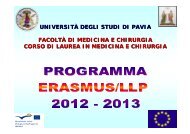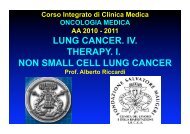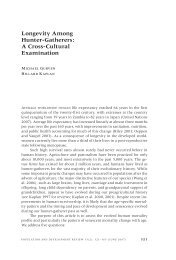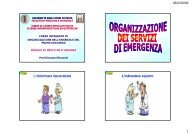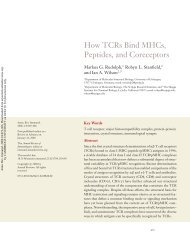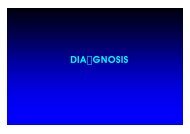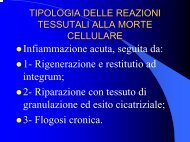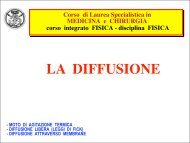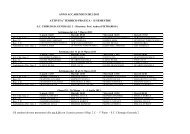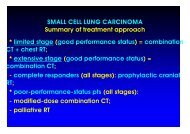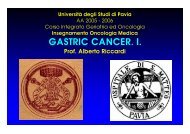Overview of CPR
Overview of CPR
Overview of CPR
Create successful ePaper yourself
Turn your PDF publications into a flip-book with our unique Google optimized e-Paper software.
Summary <strong>of</strong> BLS ABCD Maneuvers for Infants, Children, and Adults (Newborn Information Not Included)<br />
Adult<br />
Child<br />
Infant<br />
Lay rescuer: 8 years<br />
Lay rescuers: 1 to 8 years<br />
Under 1 year <strong>of</strong> age<br />
Maneuver<br />
HCP: Adolescent and older<br />
HCP: 1 year to adolescent<br />
Airway Head tilt–chin lift (HCP: suspected trauma, use jaw thrust)<br />
Breathing Initial 2 breaths at 1 second/breath 2 effective breaths at 1 second/breath<br />
HCP: Rescue breathing without chest<br />
10 to 12 breaths/min<br />
12 to 20 breaths/min (approximate)<br />
compressions<br />
(approximate)<br />
HCP: Rescue breaths for <strong>CPR</strong> with<br />
advanced airway<br />
8 to 10 breaths/min (approximately)<br />
Foreign-body airway obstruction Abdominal thrusts Back slaps and chest thrusts<br />
Circulation HCP: Pulse check (10 sec) Carotid Brachial or femoral<br />
Compression landmarks Lower half <strong>of</strong> sternum, between nipples Just below nipple line (lower<br />
half <strong>of</strong> sternum)<br />
Compression method<br />
Heel <strong>of</strong> one hand, other hand Heel <strong>of</strong> one hand or as for adults 2 or 3 fingers<br />
Push hard and fast<br />
on top<br />
HCP (2 rescuers):<br />
Allow complete recoil<br />
2 thumb–encircling hands<br />
Compression depth 11 ⁄2 to 2 inches Approximately one third to one half the depth <strong>of</strong> the chest<br />
Compression rate Approximately 100/min<br />
Compression-ventilation ratio 30:2 (one or two rescuers) 30:2 (single rescuer)<br />
HCP: 15:2 (2 rescuers)<br />
Defibrillation AED Use adult pads<br />
Use AED after 5 cycles <strong>of</strong> <strong>CPR</strong> (out <strong>of</strong> No recommendation for<br />
Do not use child pads<br />
hospital).<br />
infants<br />
Use pediatric system for child 1 to 8 years<br />
if available<br />
HCP: For sudden collapse (out <strong>of</strong><br />
hospital) or in-hospital arrest use AED as<br />
soon as available.<br />
1 year <strong>of</strong> age<br />
Note: Maneuvers used by only Healthcare Providers are indicated by “HCP.”<br />
● Lay rescuers should use a 30:2 compression-ventilation<br />
ratio for <strong>CPR</strong> for all victims.<br />
● Rescuers should compress over the lower half <strong>of</strong> the<br />
sternum, at the nipple line (as for adults).<br />
● Lay rescuers should use 1 or 2 hands, as needed, to<br />
compress the child’s chest to one third to one half the depth<br />
<strong>of</strong> the chest.<br />
● Lay rescuers and lone healthcare providers should use a<br />
compression-ventilation ratio <strong>of</strong> 30:2.<br />
● Healthcare providers (and all rescuers who complete the<br />
healthcare provider course, such as lifeguards) performing<br />
2-rescuer <strong>CPR</strong> should use a 15:2 compression-ventilation<br />
ratio until an advanced airway is in place.<br />
For the Adult<br />
Recommendations for lay rescuer and healthcare provider<br />
chest compressions for adult victims (about 8 years <strong>of</strong> age and<br />
older) include the following:<br />
● The rescuer should compress in the center <strong>of</strong> the chest at<br />
the nipple line.<br />
● The rescuer should compress the chest approximately 1 1 ⁄2<br />
to 2 inches, using the heel <strong>of</strong> both hands.<br />
Comparison <strong>of</strong> <strong>CPR</strong> skills used for adult, child, and infant<br />
victims are highlighted in the Table.<br />
Part 3: <strong>Overview</strong> <strong>of</strong> <strong>CPR</strong> IV-15<br />
<strong>CPR</strong> for Newborns<br />
Recommendations for the newborn are different from recommendations<br />
for infants. Because most providers who care for<br />
newborns do not provide care to infants, children, and adults,<br />
the educational imperative for universal or more uniform<br />
recommendations is less compelling. There are no major<br />
changes from the ECC Guidelines 2000 recommendations for<br />
<strong>CPR</strong> in newborns 28 :<br />
● The rescue breathing rate for the newborn infant with<br />
pulses is approximately 40 to 60 breaths per minute.<br />
● When providing compressions for newborn infants, the<br />
rescuer should compress to one third the depth <strong>of</strong> the chest.<br />
● For resuscitation <strong>of</strong> the newborn infant (with or without an<br />
advanced airway in place), providers should deliver 90<br />
compressions and 30 ventilations (about 120 events) per<br />
minute.<br />
● Rescuers should try to avoid giving simultaneous compressions<br />
and ventilations.<br />
Important Lessons About <strong>CPR</strong><br />
What have we learned about <strong>CPR</strong>? To be successful, <strong>CPR</strong><br />
must be started as soon as a victim collapses, and we must<br />
therefore rely on a trained and willing public to initiate <strong>CPR</strong><br />
and call for pr<strong>of</strong>essional help and an AED. We have learned<br />
that when these steps happen in a timely manner, <strong>CPR</strong> makes



